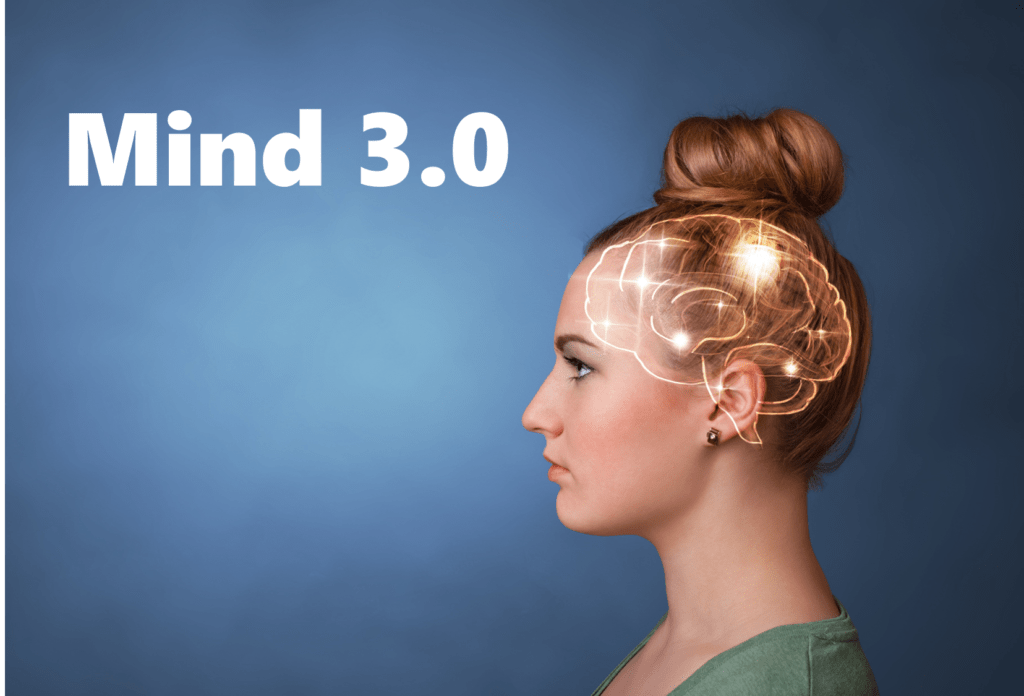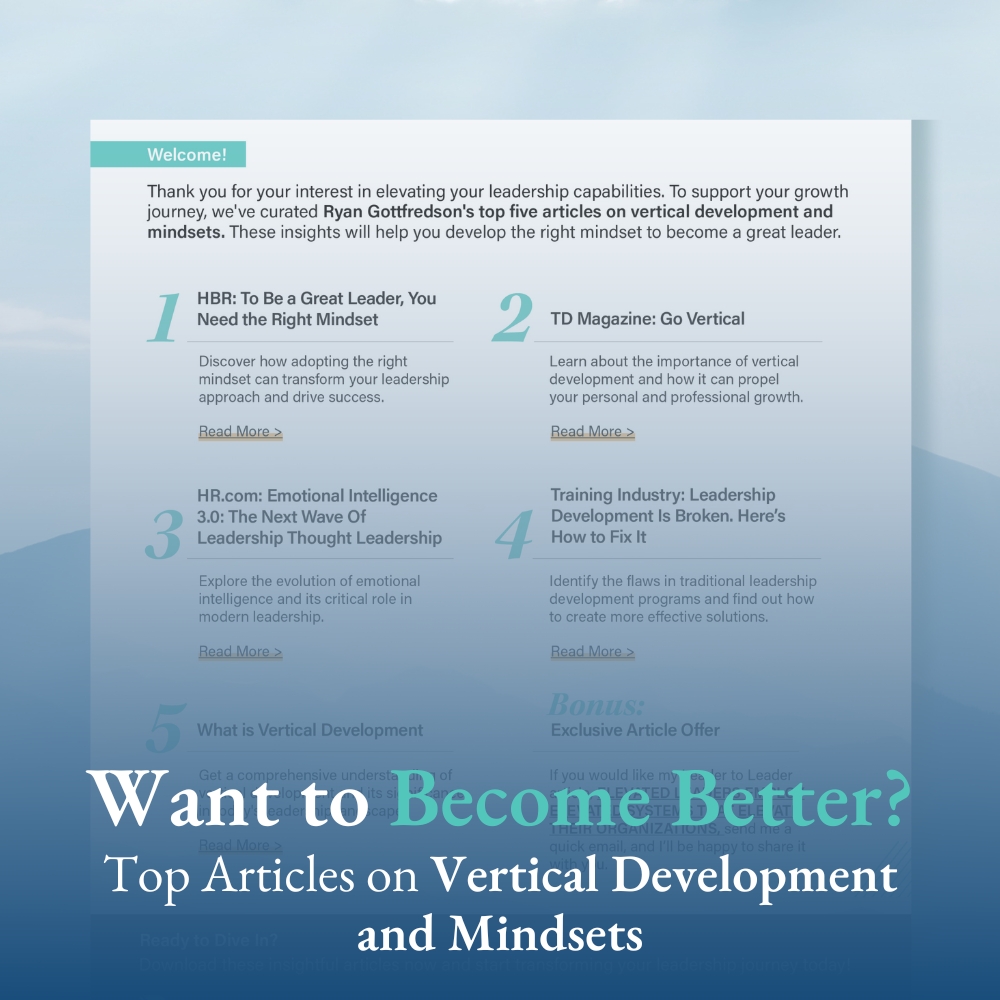Vertical development is a form of development that focuses on upgrading one’s internal operating system (i.e., becoming better). It is all about enhancing one’s ability to make meaning in more cognitively and emotionally sophisticated ways.
50+ years of research and thought-leadership have led to the identification of different levels of cognitive and emotional sophistication that individuals can elevate to.
While there are multiple frameworks identifying various vertical development levels, they all boil down to three levels. I call them:
- Mind 1.0 (64% of all adults and 7% of executives primarily operate at this level)
- Mind 2.0 (35% of all adults and 85% of executives primarily operate at this level)
- Mind 3.0 (1% of all adults and 8% of executives primarily operate at this level)
In my previous two articles, I went into detail on Mind 1.0 and Mind 2.0.
In this article, I will go into detail on Mind 3.0.
Mind 3.0 – Contribution Mode
In Mind 1.0, our internal operating system is programmed to stand in. To be safe, comfortable, and belong.
In Mind 2.0, our internal operating system is programmed to stand out. To advance, get ahead, and rise above.
In Mind 3.0, our internal operating system is programmed to contribute, to add value, and to lift.
As you can hopefully see, there is an important and big difference between Mind 1.0/Mind 2.0 and Mind 3.0. When we are in either Mind 1.0 or Mind 2.0, our focus is on ourselves (safety or standing out) and the value we are receiving. But, when we are in Mind 3.0, we are focused much more on others and the value we are contributing.
In Mind 3.0, we have the empowering fears of not living up to our most ideal self, not fulfilling our purpose, and not lifting.
When we have these needs and desires that exist beyond ourselves, we don’t feel the need to hold tightly to our own personal identities and to looking good, being right, having problems, or being passed up. In fact, we are programmed to think that if it takes us looking bad, being wrong, having problems, and being passed up to help others get ahead, we are willing to do that.
When we operate in Mind 3.0, we are balanced, we are centered, we are a wise sage.
The Hallmark of Mind 3.0 People
Mind 1.0 people are dependent thinkers.
Mind 2.0 people are independent thinkers.
Mind 3.0 people are interdependent thinkers.
They recognize that the world is complex and ambiguous, and rather than try to simplify, they are fine sitting in the complexity and ambiguity. While it might be easy to think linearly (cause-and-effect) or in polarities (either-or), they recognize that few things are linear or polar, and thus it is better to look at the entire system and interdependencies within the system.
For example, take a social issue like gun control (a hot topic at the moment). They don’t try to simplify this issue and jump to one side or the other. They recognize that there are multiple positions, each with its own pros and cons. And, they want to understand all of these positions, because by doing so, they will be able to navigate that issue in the most effective way.
In fact, they tend to want to avoid thinking in “what’s right” and “what’s wrong.” This is because the world is too complex for that, and they recognize that what seems right or wrong in the moment is commonly not right or wrong in the future. Thus, they are more values-oriented. And, not being attached to what’s right and what’s wrong, they are able to look at information objectively.
Being an interdependent systems thinker, they don’t get mired down in the now, the short-term, or the most immediate needs, which Simon Sinek refers to as playing the finite game. Instead, while they recognize the importance of the now, they also recognize the value of the future. They know that there is value in making sacrifices in the moment to improve the future. This is what Simon Sinek refers to as playing the infinite game. Mind 3.0 people are the ultimate infinite game players.
Unfortunately, very few people and executives operate at this level.
Other Mind 3.0 Characteristics
Operating in this centered, balanced, and wise sage place allows for the following Mind 3.0 Characteristics: They are:
- Present
- Patient
- Grounded
- Far-sighted
- Intentional and purposeful
- Grateful
- Emotionally intelligent
- Respectful of self and others
- Outward-minded, accepting, and empathetic
- Perspective seekers and questioners of others and of traditions
- Disruptive innovators
- Focused on the drivers of outcomes (e.g., engagement, culture, psychological safety), instead of the outcomes themselves
- Ambidextrous – They are able to bring different versions of themselves to the situations they face. If they need to be protective, they can do that. If they need to hit goals, they can do that too.
- Aware of the power of context and the effect it has on people
- Able to see failure as an opportunity to grow
- Able to admit when they are wrong
- Willing to be vulnerable, as they know that is how trust is built
- Willing to wade through problems, as problems are a necessary part of charting into unknown territory
- Patient
- Focused on contributing, not proving themselves
- A seeker of truth and thinking optimally
- Open to different and diverging opinions and perspectives
- Able to hold the diverse interests of diverse stakeholders simultaneously
- Willing to seek out how they may be part of the problem
- Agile and willing to embrace change
- Activators and leaders of change
- Able to reflect on and sit with contradictions and paradoxes – shades of grey thinkers
- Quick to come up with hypotheses, but slow to come to conclusions
- Empowerers and power sharers
- Outside-the-box thinkers
- Interested in the inner experiences of others
As a whole, there are really no downsides to operating in Mind 3.0.
Mind 3.0 Leader
As mentioned, very few people and executives operate at this level. But, when people operate at this level, this is when magic occurs.
Gandhi, Abraham Lincoln, Martin Luther King Jr., and Nelson Mandela are commonly recognized as being great leaders, people who lifted the world. After studying their lives, I believe their ability to lift the world was they operated with a Mind 3.0 internal operating system.
For example, Nelson Mandela had every reason in the world to retaliate against his oppressors, but instead, he called for forgiveness. I think this is something that is only possible with a Mind 3.0 operating system.
A current leader that seems to operate in Mind 3.0 is Satya Nadella. And, since he has taken over as CEO of Microsoft, magic has occurred. Their market cap and stock price are up six-fold after 15 years of stagnation.
Mind 3.0 leaders are impactful because they aren’t focused on themselves and their ego. They are focused on contributing and lifting. They don’t hold tightly to outcomes, they focus intensely on the drivers of outcomes. They care about culture, trust, and psychological safety more than the outcomes because they recognize that these elements are necessary for long-term and sustained success. Those in Mind 1.0 and Mind 2.0 are willing to sacrifice culture, trust, and psychological safety for short-term (selfish) success.
Since they see with complexity and are willing to sit in complexity, they can best navigate complexity and change. In fact, I might go so far as to say that organizations are only able to effectively change and adapt if they have a Mind 3.0 leader. Mind 1.0 and Mind 2.0 operating systems are unable to lead change and transformation.
Summary
I wish I saw more Mind 3.0 in myself, but by learning about Mind 3.0, I now know what to aspire and work toward.
If you feel any way like me, it is important to realize that it is possible for us to elevate our cognitive and emotional sophistication to the point where we operate primarily in Mind 3.0.
The key to doing this is to focus on our mindsets. This is because we need to see and make meaning of our world in more cognitively and emotionally sophisticated ways.
If you want to learn more about vertically developing to Mind 3.0 through a focus on mindsets, please check out my Vertical Leadership Development White Paper.











One Response